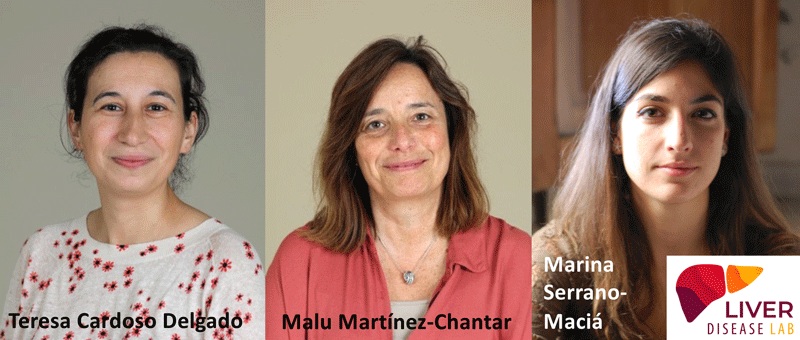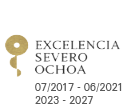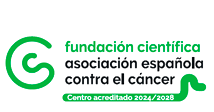
2021/07/01
New key mechanism in the development of non-alcoholic fatty liver disease identified
Alterations in neddylation have been shown to be involved in some liver diseases such as liver cancer, fibrosis and cirrhosis, and now in the development of non-alcoholic fatty liver disease.
Pharmacological inhibition of the neddylation process has been shown in animal models to reduce fat levels in fatty liver, as well as inflammation and cell damage.
Research findings have been published in the journal Molecular Metabolism.
(Bilbao, 1 July 2021). Dr. Teresa Cardoso Delgado and predoctoral researcher Marina Serrano have recently had an article published in the journal Molecular Metabolism on new advances in the study of non-alcoholic fatty liver disease, a condition prior to liver cancer. The work describes the identification of a process that may be key to early detection of this chronic pathology before it develops into cancer. Both researchers are members of the group led by Dr. Martínez-Chantar at CIC bioGUNE, a member of the BRTA and of the CIBEREHD, and supported by the Spanish Association Against Cancer (AECC by its Spanish abbreviation).
Specifically, the process which has been studied is neddylation, a mechanism by which certain molecules produced in cells are modified to perform different functions and maintain balance. However, some alterations in this process are involved in certain liver diseases such as liver cancer, fibrosis, cirrhosis and, now, in non-alcoholic fatty liver disease.
Using both patient samples and laboratory models, CIC bioGUNE CIBEREHD researchers, in collaboration with other research groups (Rubén Nogueiras @CiMUS,Patricia Aspichueta Celaá @UPV/EHU, Jesus M Banales @Biodonostia, Matías Ávila @CIMA_unav, Jose Juan Garcia Marin @hevefarm, Dimitris Xirodimas @crbm.cnrs. fr, Rosa Barrio @CICbioGUNE) and national and international clinicians (Javier Crespo @DrJavierCrespo Hospital Marqués de Valdecilla-IDIVAL, amongst others), have observed that the levels of nedylated molecules (i.e. molecules that have undergone neddylation) are considerably heightened, suggesting that these same levels may serve as an indicator of this liver problem. Furthermore, in animal models, the researchers have found that pharmacological inhibition of the neddylation process leads to a reduction in liver fat levels, inflammation and cell damage, a strategy that could be applicable to help prevent liver cancer preceded by non-alcoholic fatty liver disease.
Research article:
https://www.sciencedirect.com/science/article/pii/S2212877821001204?via%3Dihub
About CIC bioGUNE
The Centre for Cooperative Research in Biosciences (CIC bioGUNE), member of the Basque Research and Technology Alliance (BRTA) and located in the Bizkaia Technology Park, is a biomedical research organisation conducting cutting-edge research at the interface between structural, molecular and cell biology, with a particular focus on generating knowledge on the molecular bases of disease, for use in the development of new diagnostic methods and advanced therapies. CIC bioGUNE has been accredited as a “Severo Ochoa Centre of Excellence”, the highest level of recognition for centres of excellence in Spain.
About the BRTA
The BRTA is an alliance made up of 4 collaborative research centres (CIC bioGUNE, CIC nanoGUNE, CIC biomaGUNE and CIC energiGUNE) and 12 technology centres (Azterlan, Azti, Ceit, Cidetec, Gaiker, Ideko, Ikerlan, Lortek, Neiker, Tecnalia, Tekniker and Vicometch), with the aim of developing advanced technological solutions for Basque companies.
With the support of the Basque Government, the SPRI Group and the Provincial Councils of the three regional provinces, the alliance seeks to promote collaboration among its centres, to strengthen the conditions to generate and transfer knowledge to companies, contributing to their competitiveness, and to spread Basque scientific and technological capacity beyond the Basque Country.
The BRTA has a staff of 3,500 professionals, accounts for 22% of the Basque Country’s R&D investment, generates an annual turnover of over EUR 300 million and files 100 European and international patents per year.
CIC bioGUNE, member of the Basque Research & Technology Alliance (BRTA)
About the CIBEREHD
CIBER (the Biomedical Research Centre Network), co-funded by the European Regional Development Fund (ERDF), is part of the Instituto de Salud Carlos III/ Carlos III Health Institute of the Ministry for Science, Innovation and Universities. The purpose of the Biomedical Research Centre Network for Liver and Digestive Diseases (CIBEREHD) is to promote and protect health by fostering research. This activity covers both basic research and clinical and translational aspects, and is based on the subject of liver and digestive diseases with the aim of innovating in their prevention and promoting relevant scientific and health advances through the collaboration of leading Spanish groups.
The AECC, 68 years of experience in the fight against cancer
The Spanish Association Against Cancer (AECC by its Spanish abbreviation) has been the leading organisation in Spain in the fight against cancer for the last 68 years. Its efforts are focused on highlighting the reality of cancer in Spain, identifying areas for improvement and setting in motion a process of social transformation to address them, thereby defining and achieving a comprehensive and multidisciplinary approach to the disease. As being there for people at all times is part of the organisation's DNA, its work is also aimed at helping people prevent cancer; to be with them and their families throughout the whole process of the disease if they are diagnosed with it, and to improve their future by promoting cancer research. In this sense, through its Scientific Foundation, the AECC acts as a focal point to unite social demand for cancer research, funding quality scientific cancer research programmes by public tender. The AECC is currently the social and private organisation that allocates most funds to cancer research: EUR 79 million in 400 projects, involving more than 1,000 researchers.
The Association brings together patients, families, volunteers and professionals, all working together to prevent, to raise awareness, to support those affected and to fund cancer research projects that will enable better diagnosis and treatment of cancer. Structured into 52 provincial branches, and present in more than 2,000 Spanish towns, the AECC has almost 30,000 volunteers, more than 500,000 members and 1,007 staff.
In 2019, the Spanish Association Against Cancer provided help to 318,264 people affected by the disease.
See a large version of the first picture





